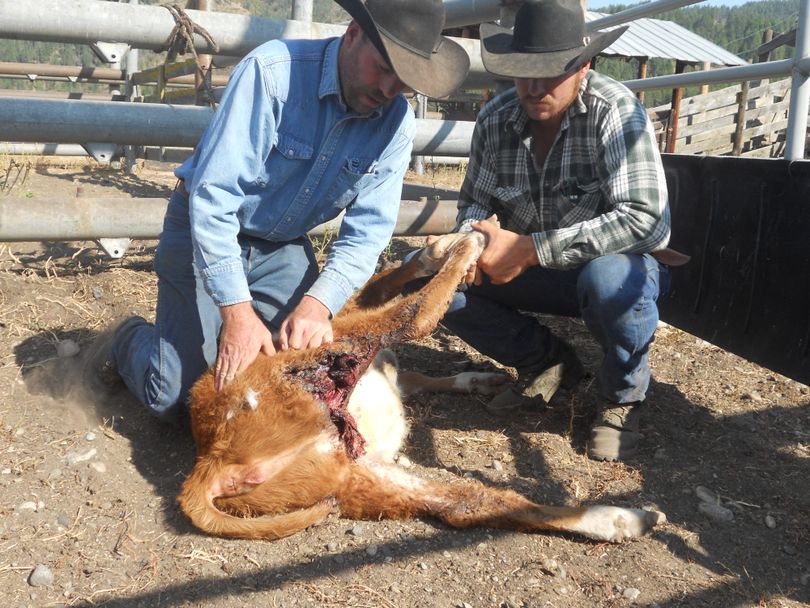More dead cattle but no dead wolves reported in Wedge

ENDANGERED SPECIES -- The Washington Fish and Wildlife Department hasn't had much to report regarding its less than fruitful efforts to curb the cattle killing by gray wolves in the Wedge area of northern Stevens County. The toll is about 15 cattle confirmed killed or injured by wolves between the Columbia and Kettle Rivers since mid-July.
But a lot of other people are talking, including the Stevens County Cattlemen's Association.
Several more cattle have been found dead or severly injured since WDFW sent officers into the Wedge area in late August, but the agency has not reported any wolves being killed in the effort.
Steve Pozzanghera, WDFW regional manager, said this afternoon that the number of officers in the area is being increased after another Diamond M Ranch calf was confirmed killed by wolves in an investigation on Sunday.
Possible reasons for the lack of effective agency response are listed in this report by Andy Walgamott of Northwest Sportsman.
Read on to see a media release from the Cattlemen's association, which is raising concern about the progress of wolf recovery and wolf management.
Stevens County Cattlemen’s Association
Contact: President Scott Nielsen, Stevenscountycattlemen@gmail.com
September 16,2012
Wolf attacks rise to 15 in Eastern Washington
Five more calves injured, dead at Diamond M Ranch
Another five calves have been attacked by wolves at the Diamond M Ranch in Eastern Washington, bringing wolf-livestock conflicts to a tally of 15 in a short three-month period. Three calves were found dead last week and two more suffered severe injuries, according to ranch co-owner Bill McIrvin.
The two calves that survived were discovered on Sept. 12 and 14. Both had suffered severe bites and torn flesh to their hindquarters. One of the calves had parts of her reproductive and urinary track torn from her body so she can no longer urinate properly.
The Diamond M, located in a portion of Eastern Washington known as the “Wedge”, has been working with the Washington State Department of Fish and Wildlife (WDFW) for several months to implement non-lethal methods to prevent damage to their cattle herd. Abiding with agency recommendations, the Diamond M waited to turn their calves out on summer range until they were 200 pounds. The ranch also employed more cowboys to patrol their grazing range.
Despite these efforts, attacks to the herd have persisted resulting in a state confirmation of 10 dead and five injured since June. The McIrvin’s herd records suggest there are likely a total of 40 dead from wolf attacks.
The WDFW recently dispatched personnel to try and “incrementally” remove a few of the problem wolves in late August, but deemed the radio-collared Alpha male and a breeding female off-limits. The restrictions are due to the fact the Gray Wolf is still listed as an endangered species in the State of Washington. The classification was imposed by the Washington State Fish and Wildlife Commission in 1980. Last winter the Commission passed the Gray Wolf Conservation and Management plan that outlines recovery objectives for the animal. As the Commission is trying to reach these objectives, some problem wolves are being spared.
Despite nearly 20 days of pursuit by WDFW on the “Wedge” wolf pack, the Department efforts have not brought an end to the aggressive wolf pack behavior.
The McIrvins feel this is due to a lackluster effort on the part of WDFW, who has sent out teams with no wolf hunting experience and insufficient equipment.
“They need someone who has a night scope and is prepared to actually be out at all hours in order to get the job done,” said McIrvin. “The wolf plan allows for trapping, euthanizing and shooting so there are several options available, but they are not being utilized.”
McIrvin also noted that a study in the wolf plan described positive outcomes when the public was involved in the wolf control process.
“The WDFW even noted in their own wolf plan that when livestock producers are allowed to be involved in taking care of problem wolves, offending wolves are more likely to be targeted and it can eliminate the need for agency control. It said shooting at wolves can also encourage them to be wary of humans,” McIrvin related. “It also said allowing livestock producers to address their own problems can reduce animosity toward the agency and its personnel. I think we could use a bit of that right now.”
However, McIrvin noted that taking out one or two wolves will likely not solve his conflicts with the predator.
“We want WDFW Director Phil Anderson and the Fish and Wildlife Commission to consider delisting the wolves in Eastern Washington in a shorter time frame than currently outlined in the plan,” he said. ”We have nine of the 12 packs in the state in Eastern Washington, which is more than our fair share. We want them immediately delisted in Eastern Washington.”
The state Wolf Conservation and Management plan currently divides the state into three sections: Eastern Washington, the North Cascades and the Southern Cascades/Northwestern Coast. There are currently nine wolf packs in the Eastern Washington section, three in the North Cascades and none in the Southern Cascades/Northwestern coast.
Stevens County Cattlemen’s Association President Scott Nielsen agreed.
“We believe the wolf recovery objectives are being met much faster than the Department anticipated and we are asking for the tools to create a balance here,” said Nielsen. “Many of us deal with predators on our cattle ranges, but with the wolf there are so many imposed regulations and artificial controls that the problem can’t be practically addressed.”
